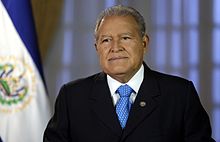Salvador Sánchez Cerén
| Salvador Sánchez Cerén | |
|---|---|

Salvador Sánchez Cerén in 2016
|
|
| President of El Salvador | |
|
Assumed office 1 June 2014 |
|
| Vice President | Óscar Ortiz |
| Preceded by | Mauricio Funes |
| Vice President of El Salvador | |
|
In office 1 June 2009 – 1 June 2014 |
|
| President | Mauricio Funes |
| Preceded by | Ana Vilma de Escobar |
| Succeeded by | Óscar Ortiz |
| Personal details | |
| Born |
June 18, 1944 Quezaltepeque, El Salvador |
| Political party | Farabundo Martí National Liberation Front |
| Spouse(s) | Margarita Villalta de Sánchez (m. 1968) |
| Residence | Presidential House |
| Alma mater | Alberto Masferrer Salvadoran University |
| Religion | Roman Catholicism |
| Signature |  |
Salvador Sánchez Cerén (born 18 June 1944) is a Salvadoran politician and the current President of El Salvador. He took office on 1 June 2014, after winning the 2014 presidential election as the candidate of the left-wing Farabundo Martí National Liberation Front (FMLN). He previously served as Vice President from 2009 to 2014. He was also a guerrilla leader in the Civil War and is the first ex-rebel to serve as president.
Sánchez Cerén was born in Quezaltepeque and was the ninth of twelve children, three of his siblings died at young age. His parents struggled to raise nine children. His father, Antonio Alfonso Sánchez, is a carpenter and his mother, Dolores Hernández, is a market seller who worked hard to give their children a better future. Salvador Sánchez Cerén at a young age had to work with his family to help the family survive. At a young age he was exposed to collective work. His working-class background has always characterized Salvador Sánchez Cerén as a man of communal living, anti-free trade, and redistribution of wealth. He attended Escuela de Varones Jose Dolores La Reynaga for his middle school education. He attended Alberto Masferrer School in San Salvador and it was there where his political consciousness and participation developed. After graduating as a teacher, he taught for ten years in public and rural schools.
His political ideology derives from the various democratic and revolutionary organizations of which he was a member. He became politically active in the late 1960s when he was a student at Alberto Masferrer School, but he was not part of any political organization until he was introduced to the Unified Popular Action Front (FUAR or Frente Unido de Accion Revolucionaria). The FUAR exposed him for the first time to the political arena and allowed his involvement in the student movement.
He was a member of the PRAM (Partido Revolucionario Abril y Mayo), a political party that was against the dictatorship and advocated anti-imperialism. Then he joined (UDN) Union Democratica Nacionalista and PAR (Partido Accion Renovadora). He was also a participant of the (UNO) Union Nacional Oppositora as member of the UDN. In essence his experience and the things he learned in San Salvador at Masferrer school from his peers he took back to his town and began to implement it. He was an active member of the ANDES 21 de Junio, a teachers union that practiced and believed in the ideas of Paulo Freire and his analysis on pedagogy. In the 1970s he joined the Fuerzas Populares de Liberación "Farabundo Martí" (FPL), one of the five left-wing organizations, all of differing Marxist–Leninist tendencies, that later merged to form the Frente Farabundo Martí para la Liberación Nacional (FMLN).
...
Wikipedia
